
Learning to track for beginners (with many picture examples)
👉 The key facts from this guide
- Tracking allows you to get to know nature and the animals in your environment better.
- When tracking, you observe ALL traces that animals have left behind, not just footprints.
- Start tracking in your immediate surroundings, such as parks, forests, or meadows.
- Look out for animal trails, droppings, marking trees and other signs.
- Record your discoveries and use identification books to identify the animals.
- Practice patience and attention to discover more and more traces and stories of the animals.
What if you were able to know which animals live in your surroundings? Wouldn't that be fantastic?
You would get to know nature in a versatile way.
Suddenly, traces appear that show you the diversity of animals living with you.
And already you immerse yourself in a (still) foreign world.
This is tracking - the searching, identifying, and interpreting of traces of all kinds.
The forest is full of stories
Most people walk through the forest and are just tourists. They hardly notice anything, even though a lot is happening around them.
And we can get to the bottom of these events - caused by the animals.
Suddenly, you see a trail. Someone has walked by here. But in which direction? And how fast was the animal? And was it alone? What was it trying to do? Was it fleeing?
Did you notice what's happening here?
I ask questions and from that a reconstruction of the time when the animal walked along the place emerges.
Animal tracks tell a story.

And often every story is unique. A glimpse into the life of an animal.
Through tracking, you have the opportunity to get to know this excerpt and thus also the life of the animal.
Do you know what is most typically told by the campfire? And what my children love to hear most when they fall asleep in bed? Exactly, the stories of the animals.
Tracking is more than just determining footprints
I became aware of tracking through my passion for bushcraft. Because bushcraft (What is bushcraft?) means to me that I perceive my surroundings.

What resources do I find here, what plants grow here - AND, what animals live in my environment.
Imagine you are searching for a place to spend the night, and you set up camp right on an animal trail. Then don't be surprised if a group of wild boars stands in front of your tent at night.
I always pay attention to droppings (feces from animals) and animal trails. If I find too much of it, I move on.
At the beginning of my tracker passion, I went out and photographed the tracks. Then at the end of the day, I tried to identify the "footprints" of the animals. Expert trackers refer to these imprints as "spoor".

So, I collected many footprints during my hikes.
But I also saw more than just footprints.
Among other things, a conifer tree that was completely debarked from the bottom to one meter up. And the wood under the missing bark was incredibly smooth.
I didn't see any distinct footprints, but there were definitely larger animals that were circling the tree.
And just like that, I was in the middle of holistic tracking.
When tracking, you perceive ALL traces that animals have left behind. It's about the intense perception of your surroundings.
The footprints are only a part of tracking - which became clear to me step by step.
Imagine: I walked past this tree for over a year without seeing anything.
But over time, I became more attentive. And I promise you:
You will see, hear, and smell things that you never had any idea about before.
Short on resolution: I discovered a rubbing tree. This is a tree on which red deer, wild boars or badgers rub and sniff. This gives them the opportunity to scratch themselves and combat ectoparasites (e.g., mosquitoes, fleas, lice, ticks). The resin secreted by the coniferous tree also has a disinfecting effect.

So, I have been looking for other clues since then and I keep asking myself:
"Is the environment naturally like this or were there influences from animals?"
It starts with the smallest things, like bent grass or fallen bark.
You see, tracking means getting down on your knees, taking a close look with a magnifying glass, and getting dirty ("Dirt Time").
On the other hand, other features are so large that you have to take a few steps back to see the big picture.
And another truly wonderful thing happens: You connect with nature - so with yourself, the environment, and the animals. (Read more about it here: 33 tips for more nature connection - This is how you strengthen your connection with nature).
Learning to Track: Getting Started
Many wilderness schools offer basic courses in tracking, but I want to encourage you to venture out on your own.
You can find tracks in the nearest park, on fallow land in the city as well as in the forest and meadows.
One thing is important: You should be interested, take your time, and approach the matter in a relaxed manner. Do it like in wilderness education, go hiking and let the journey become the goal.
When tracking, it's not about immediately recognizing which animal it is. It's essential that you register that something has happened.

Where can animal tracks be found?
Generally, clearly visible animal tracks can be found in fine sand or muddy soil. Particularly suitable areas are shoreline areas with moist sand near lakes, ponds, and streams. Other tracks can be found in vegetative transition zones, food sources, animal trails, and sleeping areas.
Here is a list:
- Water holes, shore areas at ponds, lakes, and rivers (sandy ground)
- Sand, fallow areas, muddy areas
- Transition zones, such as field, path, and forest
- Zones with food supply (clearings with grasses)
- Animal paths (animals' own paths)
- Sleeping places
- Nests and dens (e.g., squirrel nests)

What equipment do I need for tracking?
This is the good thing: You don't need much. Pack your curiosity and the following:
- A small book for drawing
- A pencil and an eraser
- A ruler and a measuring tape
- A camera or smartphone
With this equipment, you can get started and capture your experiences.

The tracing of animal tracks and documenting them strengthens your discoveries because you have to look closely. This way, you discover every detail.
I can only recommend to you to keep track of your trails and take notes. Sporadically, I discover so much and after just one hour, I already forget which trail the excursion started with.
At the end of the day, you take out your notes and grab a field guide for wildlife and one for tracks and signs. Then you compare your documentation and identify the animal.
Book recommendations (all four books are in front of me):
- How do I learn to track? (small, good for beginners who are not yet sure if tracking is for them)
- The Mammals of Central Europe: Observing and Identifying (For an overview of the animals with many facts)
- Animal Tracks: Tracks | Feeding Signs | Droppings | Pellets (small, okay for starters)
- TIP! Animal Tracks of Europe: Identifying and Interpreting Tracks and Signs (a must-have for any tracker who wants to become a pro - the investment is worth it!)
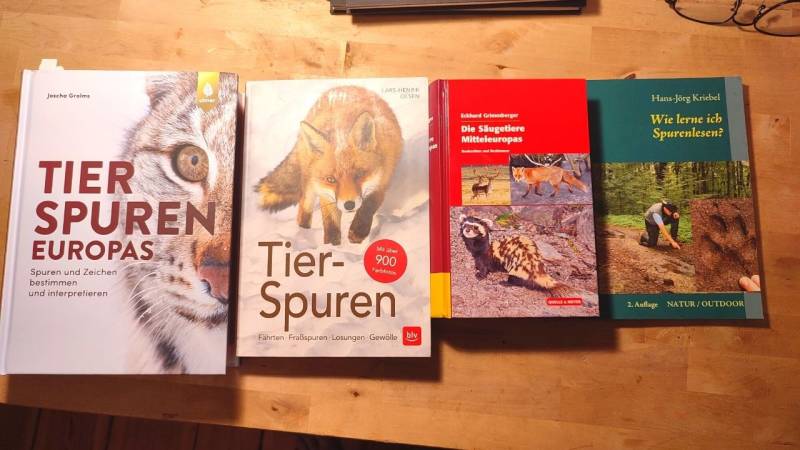
34 Examples of Animal Tracks - Learning to Read Tracks for Beginners
Below you will find examples of animal tracks that I have discovered on my excursions.
Why not keep an eye out for these tracks on your outings? You're sure to find some examples as well.

A rubbing tree of wild boars. The bristles that have gotten stuck are easily recognizable. Wild boars rub themselves against a rubbing tree after taking a mud bath and to get rid of annoying parasites.

A field hare has left its solid round to oval droppings. The difference to the deer? The droppings of hares are dry and inside like straw. They also don't smell.

A plucking place from a bird of prey. The feathers are from a dove. In general, birds of prey pluck out the feathers (quill is visible), foxes and other predators bite off the feathers (quill is no longer attached and feather is bitten off). But there are exceptions here too. Probably a sparrowhawk or a hawk was at work in the picture, as they mainly eat other birds.

A trapped cone on a deciduous tree. How did this cone get there? Solution: Woodpeckers use such spots to trap the cones to access the vitamin-rich seeds. You can see a woodpecker forge here.

In the dead tree, the cones can be particularly well trapped. On the ground, the cones are scattered over many square meters.
Read also
Feeding marks on cones? Who was it? Mouse, squirrel, woodpecker, or crossbill? – Discover, who is behind the feeding traces on cones. Guide for trackers: mouse, squirrel, woodpecker, or crossbill? Find out!

What happened here? In spring, I discovered this young maple tree with sap oozing out and injuries on the bark. Throughout the day, I saw a squirrel drinking from it. But the culprits are often woodpeckers, who drink the sweet sap that shoots from the roots into the buds in spring.

Wild boars and other animals use the mud to protect themselves from parasites and the sun. In the picture, you can see a wild boar wallow. These spots are perfect places to search for tracks. You typically find rubbing trees there as well.

Judging by its size, this is likely a deer. Deer leave an almost heart-shaped footprint with their hooves on the ground.

A deer's footprint is 3 to 6 cm long and 2.2 to 2.3 cm wide.

Typically, the dewclaws of wild boars are visible in the hoof prints. Here in the picture below, they are located on the left and right edges of the hoof prints.

The hoof print of wild boars is often round and not as narrow and elongated as that of roe deer, red deer, or fallow deer. In this photo, the dewclaws are not visible.

Unlike roe deer, a wild boar's hoof print is longer and wider. Clearly visible at the end of the hoof print is one dewclaw on the bottom right.

Many people are startled when they see this footprint. But don't worry, it wasn't a wolf, but an ordinary dog. Wolves and dogs are difficult to distinguish.
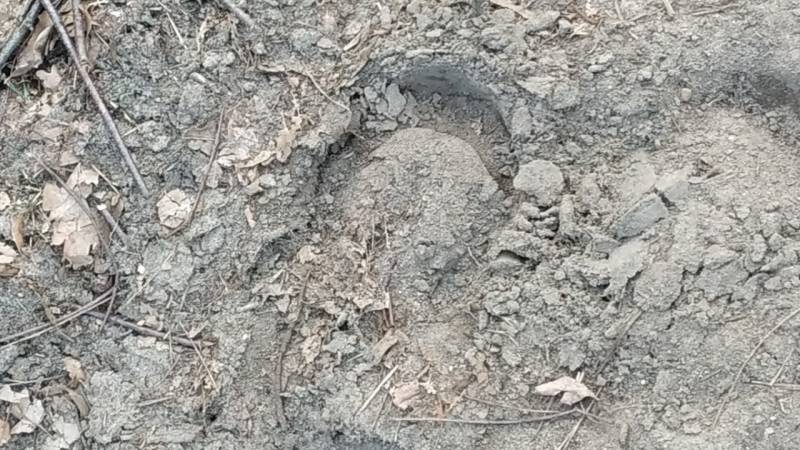
You are familiar with this imprint, aren't you? Here a horseshoe-clad horse has walked by.
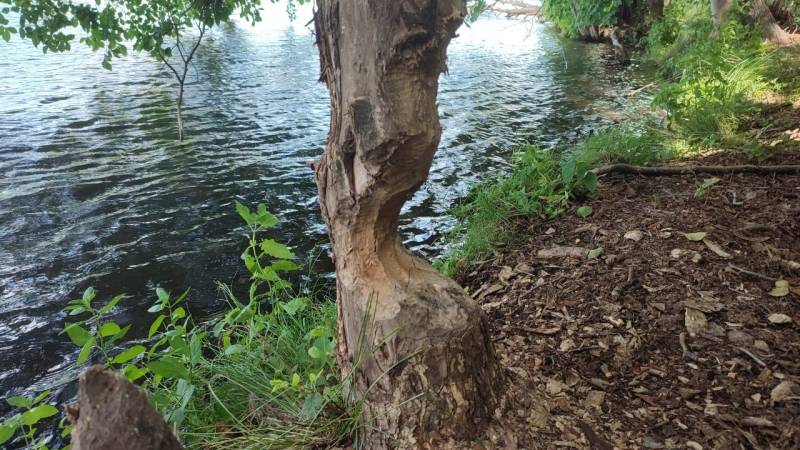
Beavers are true artists of woodworking.

You can easily recognize such animal trails by the width of the path and the absence of plants growing under the tree trunk, as well as everything being flattened. If it were a path made by humans, grass would grow under the tree trunk and the path would be wider.
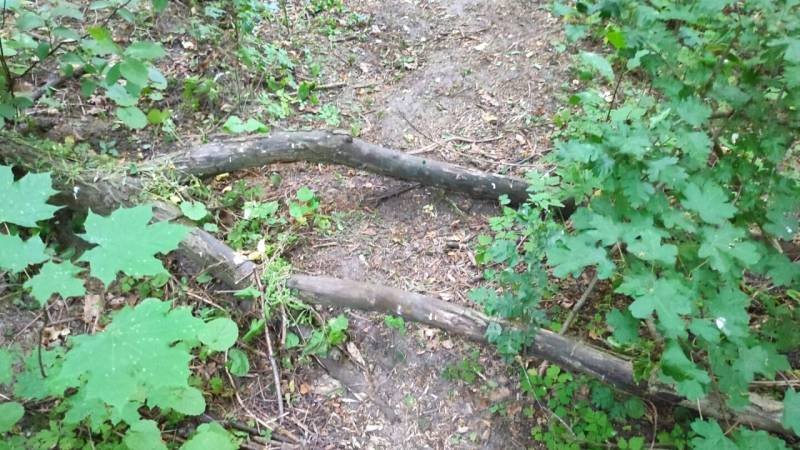
In this path, you can clearly see that animals often take this route. The fallen tree trunks are too low to crawl underneath, so the animals have to climb over them. The tree trunks are smooth on top because the animals rub against them with their bellies. In this case, there is a raccoon family living nearby.

Such finds are great for trackers. What might have happened here? And whose egg is this? Unfortunately, I didn't find a nest in the tree above.

Who left these eggshells? The color of the shells is common among many songbirds, making it difficult to determine the exact species.

Even the feces is a clue. From this, one can deduce which animal it is, what it has eaten, and when it passed through here. In the image, you can see the feces of a wild boar.

Perhaps a solution from a fox? Snails are already feasting on it.
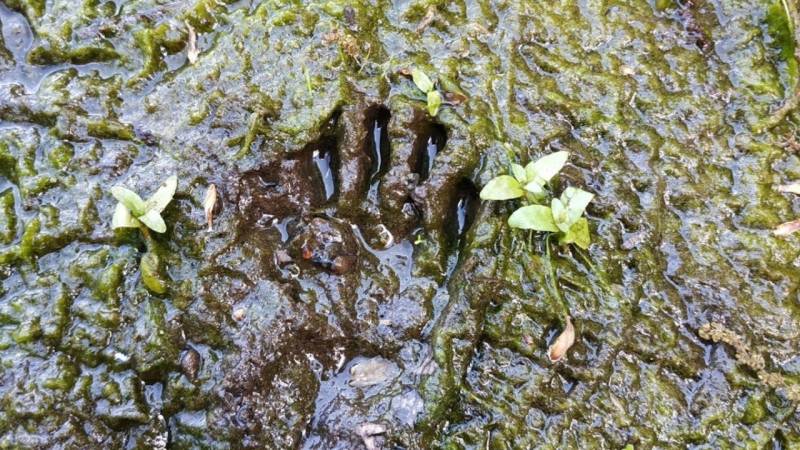
In this muddy ground, it is wonderful to read tracks. A raccoon recently passed by here.

Substrates like this wet soil are perfect for trackers. Here I couldn't determine exactly which bird it was. However, I can rule out the categories of wading birds (quail, partridge, pheasant), ducks and geese (as no webbed feet are visible), and woodpeckers. Therefore, it could be, for example, a blackbird.

If you see down feathers (at the top of the image) and feathers like those from a dove in a deciduous forest, then look up. Is there a nest of a bird of prey up there? In my case, I saw a nest up there and there were still pellets and feathers from a hawk. It is very likely that a hawk raised its offspring in that nest.

Owls and birds of prey, as well as many other bird species, regurgitate undigested food remains (bones, feathers) known as pellets or vomit balls. The image clearly shows the remains of feathers.

If you find many feathers from different birds in one place, you have probably come across a bird of prey that lives here or has its plucking place there. In the picture you can see the feathers of a hawk (left), those of a dove (middle) and those of a crow (right). The dove and the crow were the meals.

Some predator has tampered with an egg. The holes were chiseled from the outside, so it can only have been another bird. Possible culprits here are crows and magpies.

In the forest and meadows, you sometimes find scraped bark on young trees, shrubs, and branches. There are fringes at the top and bottom of the scraping. You won't find any bite marks here. That means someone must have rubbed against it. In this case, a male deer is the likely culprit, marking its territory. In spring, the male deer marks its territory with the secretion from the forehead gland located between the antlers, where the roses grow.

In the sand was this footprint of a wading bird. Length approximately 6 to 7 cm. The footprint is too small for a partridge, woodcock, and quail. Therefore, it is most likely the imprint of a pheasant.

These craters are the end of every ant. The ant lions have truly built magnificent traps here.

An ant lion. Did you know that an ant lion is a larva and then becomes an antlion?

Fine sand is ideal for finding a fresh track. In the image, you can see the footprints of a lizard. It was probably a forest lizard.

Where do these small holes come from, which are so accurately arranged? I would rather not keep you guessing for long: They are the breathing holes of the birchbark beetle, which are built during egg laying. The animals create "mother tunnels" under the bark, about 10 cm long, in which eggs are laid and from where the larvae later begin their feeding tunnels. These "mother tunnels" are ventilated through the holes.

An inconspicuous stone and yet, a "crime scene". Do you see the small shells lying there on the edge? Those are the shells of snails. A bird that is not strong enough to crack the snails itself uses the stone to access its prey. You can see a thrush forge in the picture. Mainly, you will be able to observe the song thrush smashing snails.
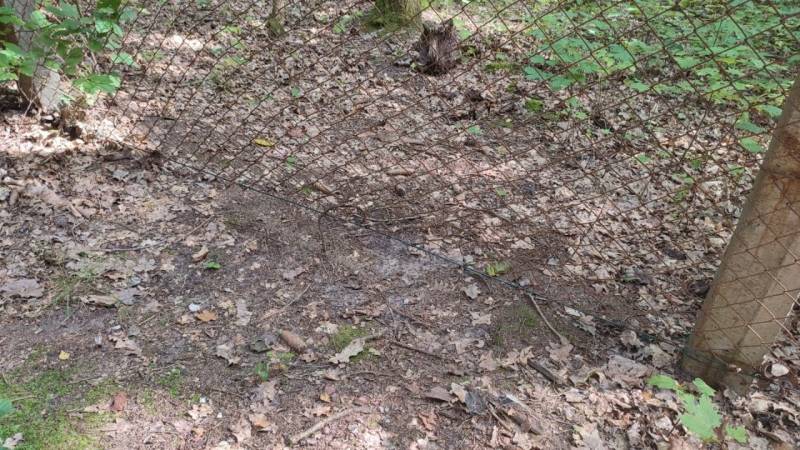
Do you see the opening under the fence? Many animals sneak through there. If you want to know exactly who, look for hair on the fence.
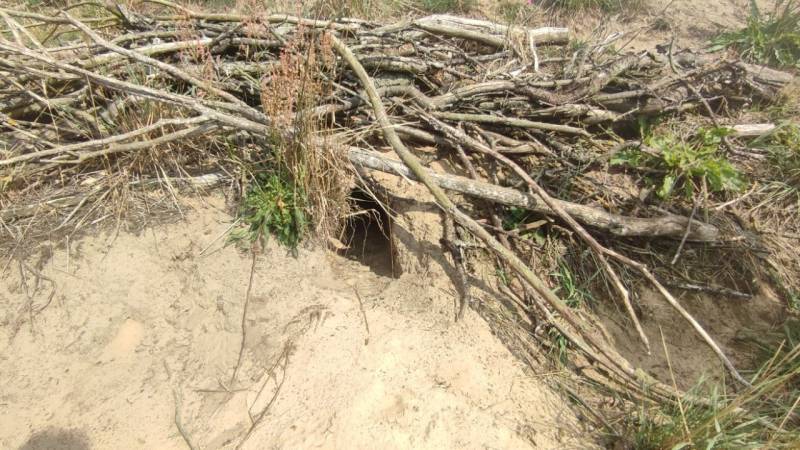
Only the fox or the badger dig such large holes - preferably in the walls of hills. Fox entrances are smaller than those of badgers. In addition, the fox digs the earth more centrally and throws it between its legs backwards - the badger digs more laterally and the earth is scattered on the left and right.

Eaten plants in the forest are an indication that deer or other herbivores may have passed by here.

Who is sneaking along the field path? Hopefully, she doesn't do her business right on the sandy path. I think you already know who has walked along here, don't you?
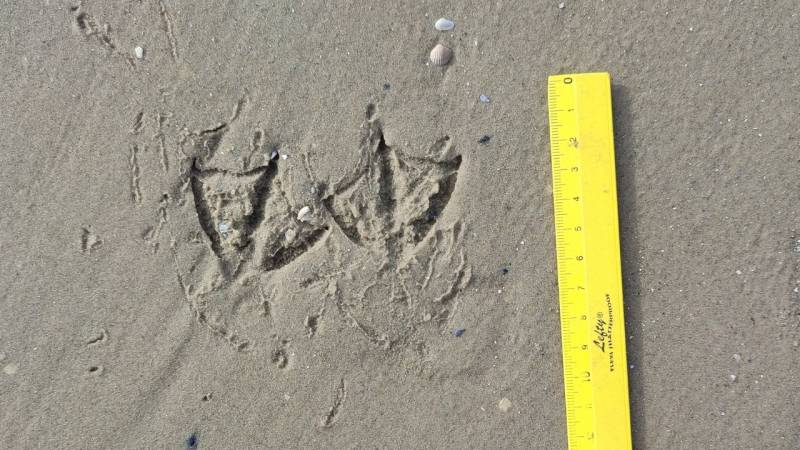
Especially on the coast in fine sand you will find many traces of birds. On the picture above you can see the footprints of a seagull that has landed here. The landing process has caused the two feet to sink particularly deeply into the sand.

If you're particularly lucky, you might even find well-preserved skulls or bones and be able to determine which animal it is.

Occasionally, you can find very fine bite marks on bones. These can come, for example, from mice that meet their calcium needs this way.
Is it allowed to collect bones in Germany found in the forest?
Generally, only the authorized hunter is allowed to take game and parts of game in his hunting area. People who still take a skull from the forest are committing a crime, as this counts as poaching.
This is stated in the German law § 292 StGB - poaching Paragraph 1 Point 2. "Things subject to hunting law" also include bones or antlers of wild animals.
The right of appropriation of skulls is reserved only for those persons entitled to hunt there.
But: whoever is allowed to acquire, is also allowed to pass on. So, you can ask the hunting-authorized hunter if you are allowed to keep the skull.
Attention, the forester (who cultivates the forest) has no right of appropriation, unless he is also the hunter.
Only hunters (who are also allowed to hunt in the respective area) have the right to appropriate game. No one else.
Is it allowed to collect feathers in German Forests?
Basically, according to the German Federal Nature Conservation Act § 44 (2) sentence 1 point 1, you are not allowed to take feathers in Germany. Protected animals or parts of them must not be appropriated. And since all native birds are considered protected animals, you are not allowed to collect their feathers.
If you are keen to know more about it, take a look at § 44 (2) sentence 1 point 1 of the Federal Nature Conservation Act or this article.
And now go on your own!
And, could I inspire you to go out? I have shown you many examples now.
The places where traces can be found, you now know as well. You still need to get a small empty booklet, and then you can start tracking.
And remember: It's not about knowing immediately which animal left the track.
It's about your attention. Walk with alert eyes and open ears through the forest, and soon you will find your first clue.
I wish you many great tracks, lots of fun tracking and tricky puzzles.
You can find even more footprints from our native animals in my small footprint database.


Author of the guide
Martin Gebhardt
Hey, I'm Martin. On my blog, you will learn the basics and numerous details about living in the wild. I think survival, bushcraft and the good life in nature are the keys to happiness. Find me here on Instagram or on YouTube. You can find more about my mission on the About Me page.
Was this guide helpful?
46 people found this guide helpful.
5.00 out of 5 points (46 Ratings)
Comments (2)
This post may contain affiliate links. So if you click on the links and make a purchase, I will receive a small commission at no additional cost to you. Click here, to learn more about it.


